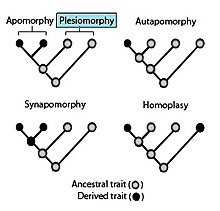Our website is made possible by displaying online advertisements to our visitors.
Please consider supporting us by disabling your ad blocker.
Plesiomorphy and symplesiomorphy


In phylogenetics, a plesiomorphy ("near form") and symplesiomorphy are synonyms for an ancestral character shared by all members of a clade, which does not distinguish the clade from other clades.
Plesiomorphy, symplesiomorphy, apomorphy, and synapomorphy, all mean a trait shared between species because they share an ancestral species.[a]
Apomorphic and synapomorphic characteristics convey much information about evolutionary clades and can be used to define taxa. However, plesiomorphic and symplesiomorphic characteristics cannot.
The term symplesiomorphy was introduced in 1950 by German entomologist Willi Hennig.
- ^ Roderick D.M. Page; Edward C. Holmes (14 July 2009). Molecular Evolution: A Phylogenetic Approach. John Wiley & Sons. ISBN 978-1-4443-1336-9.
- ^ a b Freeman, Scott, 1955- (2015). Evolutionary analysis. Herron, Jon C., 1962- (5th ed.). Harlow. ISBN 9781292061276. OCLC 903941931.
{{cite book}}: CS1 maint: location missing publisher (link) CS1 maint: multiple names: authors list (link) CS1 maint: numeric names: authors list (link) - ^ Brower, Andrew V. Z.; de Pinna, M. C. C. (2014). "About Nothing". Cladistics. 30 (3): 330–336. doi:10.1111/cla.12050. PMID 34788975. S2CID 221550586.
Cite error: There are <ref group=lower-alpha> tags or {{efn}} templates on this page, but the references will not show without a {{reflist|group=lower-alpha}} template or {{notelist}} template (see the help page).
Previous Page Next Page


